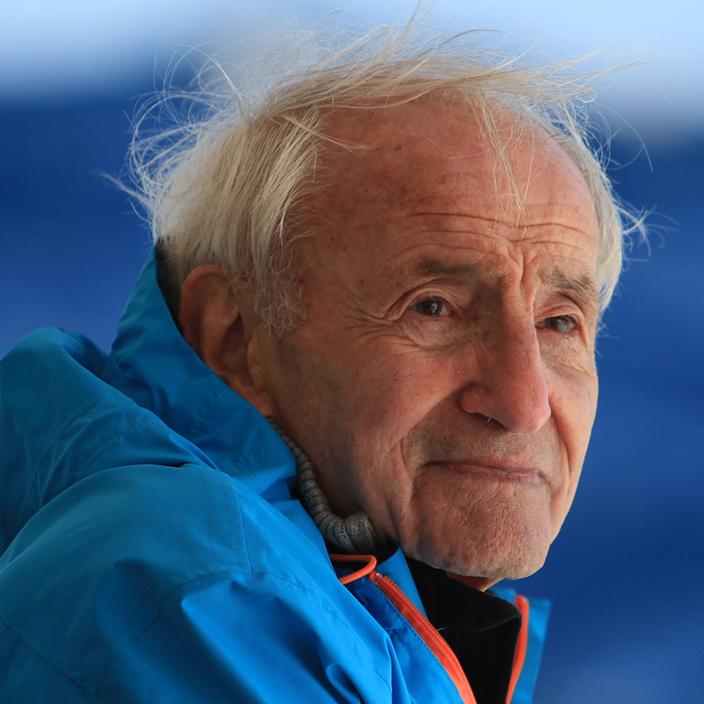
2017 Bower Science Award Theme: Perturbations of Natural Systems in the Anthropocene
Glaciologist Claude Lorius looked 420,000 years into the past and, like an oracle, predicted our future. During his 60-year career, he explored the Antarctic continent, collecting ice cores that would tell the tale of Earth’s climate history. The data he extracted reveal a stark reality: the Earth is now warming at the hands of its human inhabitants.
Lorius earned his bachelor’s and master’s degrees in physics at the University of Besançon in France in the mid-1950s. His career in glaciology began after answering an ad on a school bulletin board requesting researchers for the International Geophysical Year. He soon found himself pioneering expeditions to unexplored areas of Antarctica. His first few excursions were intended to gather information about the environmental conditions at select base camps across the vast, harsh continent. His team measured wind speed, temperature, elevation, and the thickness of the ice—data that would be used later to model the ice sheet’s flow.
In 1963 he defended his physics Ph.D. thesis, which described how past temperatures can be reconstructed using measurements of oxygen and hydrogen isotopes in ice—a method still employed when analyzing ice cores today. A year later, Lorius hypothesized that air bubbles in the ice samples must represent the composition of atmospheric gases at the time of encapsulation. That same year, he joined the Laboratory of Glaciology and Geophysics of the Environment at the French Center for Scientific Research (CNRS) to continue studying ice cores and investigating his hypothesis. He remained at CNRS throughout his career, eventually becoming director emeritus of research.
Lorius and his colleagues collected at least three tons of ice cores during 20 expeditions, exploring many corners of what he described as the “mercilessly hostile” Antarctic continent. He has sampled the coastal region of Adelie Land, Victoria Land’s mountain ranges, and, at the highest elevations (2,400 meters), the continental glacier at Charcot.
Heavy drilling in savagely cold conditions required funding and expertise from an international collaborative of researchers and logistics specialists. Lorius worked together with polar experts from the U.S., Great Britain, Australia, and the former U.S.S.R.—these being particularly remarkable since a significant number of the expeditions occurred during the Cold War.
His hunch about ice core bubbles and his method for reconstructing past temperatures would provide a wealth of environmental insights about our planet. At the end of the 1970s, Lorius collected ice cores from greater and greater depths, peering even farther back into the Earth’s climate history. From the results of the analysis of these cores, scientists realized that the Earth naturally undergoes periods of warming and cooling. This information was valuable, but ice cores from even deeper depths that glimpsed further back in time were necessary to fully understand Earth’s temperature trends and unequivocally determine what induced the current warming period.
A decade later, Lorius ventured back to Antarctica to drill at Vostok, the most remote (1,400 km from the nearest coast) and coldest station on Earth, to harvest a 2,083-meter ice core unaltered by moving ice sheets. The core he retrieved contained ice that dated back hundreds of thousands of years. The results confirmed that over geologic time frames, the Earth follows warming-cooling cycles that coincide with increases and decreases in greenhouse gases. Ice cores obtained more recently have extended this paleoclimate record back to 800,000 years before the present. And the ice core data revealed that never in the past 800,000 years have greenhouse gases been so high. “We have confirmed that there is a link between the variations of temperature and those of the composition of the atmosphere. In hot periods, the concentration of greenhouse gases is higher than in the Ice Age. And laboratory analyses have shown an acceleration in the rise in temperature and in the greenhouse gas content since the beginning of the Industrial Era some 200 years ago, a rapidity and amplitude never before observed. For us it was obvious that human activities were responsible,” Lorius said.
Claude Lorius has been honored with many awards, including the Humboldt Prize, the Belgica Medal, the Italgas Prize, the Tyler Prize for Environmental Achievement, and the Balzan Prize for climatology. He is an officer of the Legion of Honor and a member of the Académie des Sciences and the Académie des Technologies of France. He is also a foreign member of the Russian Academy of Science, a member of the Academia Europaea, and a European Geophysical Society Fellow. Most recently he is the subject of a documentary by Luc Jacquet about his climate change studies titled, Ice and Sky.
In a review of Ice and Sky, The Guardian describes Claude Lorius as “an intriguing blend of explorer, scientist and survivor.” We can also add, advocate for the planet and by extension, the human race.
Information as of April 1, 2017

